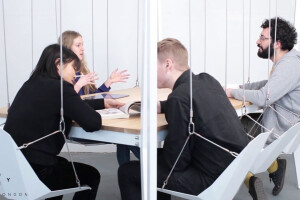EY wavespace is a global network of 25 interconnected cutting-edge centres of technological excellence located in the world’s most dynamic and innovative urban locations. Wavespace in Rome has experimentally adopted a design method based around research carried out in the neurosciences and then applied to the design of architectural space.
The functional concept was developed by EY in partnership with experts in behavioural psychology and the neurosciences. The architectural concept is based on a brief written by Davide Ruzzon, Director of TUNED/Lombardini22, in conjunction with EY and then architecturally implemented by DEGW. For the very first time,research and experimentation carried out as part of TUNED has been incorporated in an organic project. TUNED is an across-the-board Lombardini22 project created by Ruzzon himself in 2016 that is now a fully-fledged means of applying the neurosciences to architecture.
7 ROOMS (+ ONE) form wavespacethat takes up part of the seventh floor of EY’s new office in Rome, sharing the same underlying stylistic concept of a beehive, here embodied in a special mediation space evoking the form of an irregular rounded hexagon enveloping the stairs-lifts hub in expanded steel walls holding the utilities and setting out the flows through to the various functional areas. The wavespace areas are divided into seven rooms, each devoted to a specific activity to jointly create a striking experiential sequence.
BUSINESS, EMOTIONS, BODY AND SPACE are the values DEGW has incorporated in the interior layout through the wavespace concept. From a design viewpoint, the problem was: how to activate the space?
Every human activity triggers off different emotional expectations that architecture can “mirror” through the layout of its sculptural, material, rhythmic, luminous, chromatic and acoustic components. The aim is to balance out pre-reflective and cognitive factors to strengthen the activity being carried out. Since interior architectural space is always crossed through by bodies, the body’s movements and itsdistinctive kinematicsare taken as a conceptual reference point for the morphology of the space in question: so spatial configurations accompany users triggering off a series of underlying feelings associated with the aims of the various premises. Translating the kind of “emotional kinematics” the body experiences into dynamic spaces is the key analogy in this project. An architectural project with extremely interesting scientific implications is the best way to sum up EY wavespace.
“The neurosciences are now providing architects with predictive knowledge of immense scope” - so David Ruzzon claimed, the Director of TUNED/Lombardini22 and scientific head of the NAAD master’s degree in Neuroscience Applied to Architectural Design at IUAV in Venice - “and it is now hard not to follow this path. Understanding how our deepest needs try to find harmony between activities and spatial form in workplaces is now feasible. Although this is, indeed, scientific knowledge, it makes no pretensions to be highbrow. It is a humble kind of understanding at people’s disposal that now makes usadopt a more conscientious attitude to mental, physical and relational well-being in the office. Let’s not forget that, according to the World Health Organisation, burn out and stress (now officially classed as syndromes) cost the business world about $1 trillion a year”.



























